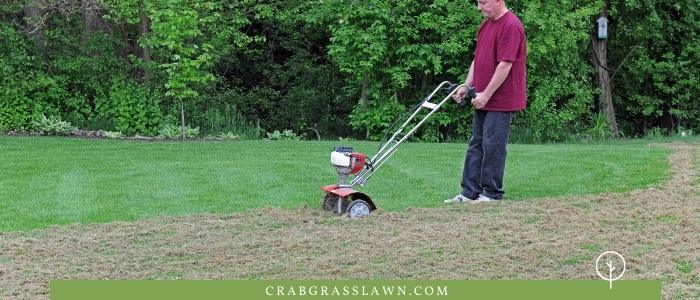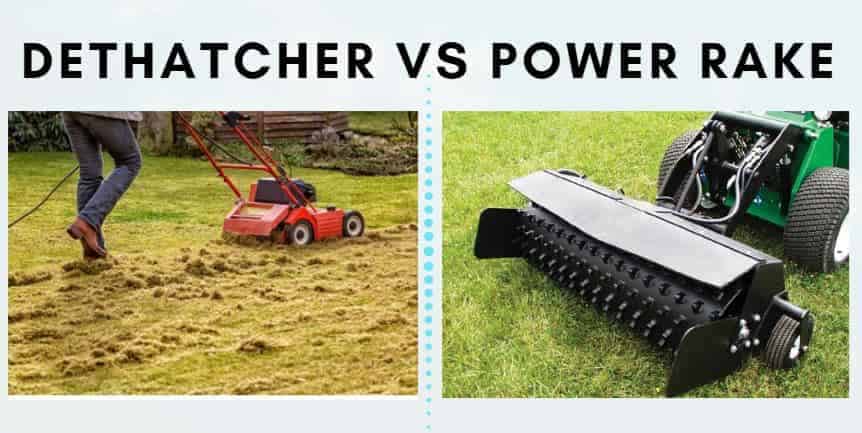I use a power rake or dethatcher to clear out dead grass, excess grass clippings, and thatch buildup.
Quick Answer
But what is the difference between a power rake vs dethatcher, and how do they work?
- A power rake removes thatch that exceeds 1/2 inch in thickness
- A dethatcher removes thatch that is up to 1/2 inch thick
The following guide highlights the key differences between these two tools to help you decide which tool is right for the job.
Is a Power Rake and a Dethatcher the same thing?
A power rake is similar to a dethatcher, but the two remove thatch and debris in different ways. Both power raking and dethatching fix the same problem in the lawn – excess thatch and debris.
- Take a thatch sample and if there’s more than half an inch of spongy, dead organic matter at the top, go ahead and dethatch using a dethatcher.
- If your lawn has a visible thick layer of dead grass or debris, use a power rake to remove it and allow fertilizer and other treatments to penetrate effectively.
- Dethatchers are suitable for less than half an inch of thatch while power rakes are suitable for more than half an inch of thatch.

Thatch buildup starts as dead grass, stolons, and grass clippings failing to decompose at a good rate. At an early stage, it will just be dead matter lying on top of the soil, which you can fix by power raking.
As time goes by and if decomposition takes place but at a slower rate, the dead matter forms thatch. This thatch can be a little too much and can form a barrier on the lawn’s surface.
When you have more than a half-inch of thatch buildup in your lawn, your grass will start to look unhealthy because of the poor supply of nutrients, water, and oxygen.
That is where you want to use a dethatcher to break down the thick layer of decomposing organic matter and overseed the lawn to make it thick and full.
Power Rake vs Dethatcher – Differences

- KEEP YOUR YARD HEALTHY : dethatch in early spring or early fall for cool-season grasses, and in late spring through early summer (after the 2nd mowing) for warm-season grasses.Speed : 3700 RPM, Motor : 120 V, AC only, 60 Hz, 10 Amps
- POWERFUL MOTOR : 10A motor provides the power you need to tackle the toughest jobs
- 14” DETHATCHING PATH : allows you to complete jobs faster and more efficiently
Affiliate links and images pulled from the Amazon Product Advertising API on: 2024-04-24
Both power raking and dethatching aim at removing excess thatch in the lawn. A power rake is good for getting rid of the thick layer of debris lying on top of the soil while a dethatcher is good for removing a thin layer of decomposing organic matter that forms the topmost part of the soil in the lawn.
Power raking is a more aggressive process of removing thatch and dead matter in the lawn while dethatching is a light process that removes just a thin layer of debris that makes fertilizer absorption poor.
A dethatcher is usually spring tines that rotate and dislodge the layer of thatch and dead matter on the lawn while a power rake is usually mechanical with a dethatching blade that has rotating flails. The flails aggressively dig up thick layers of thatch from the lawn.
A dethatcher is a small machine that looks almost like push lawnmowers. Some come as extensions that you can attach to a lawn mower. On the other hand, a power rake is a heavy-duty machine that removes large amounts of thatch from a lawn.
Dethatchers are suitable for less than half an inch of thatch while power rakes are suitable for more than half an inch of thatch. Power rakes can remove up to four times the amount of thatch a dethatcher can handle.
Pro tip: A power rake can be very unforgiving on your lawn. Try to do it early to allow your lawn to heal before going dormant.
What is power raking a lawn?
Power raking addresses a much more superficial problem in the lawn. Most homeowners power-rake in spring and also in the fall when they want to overseed their lawns.
The process of power raking removes a thick layer of dead grass matter or debris sitting right on top of the soil in your lawn. This layer prevents your lawn from breathing properly.
How does a power rake work
A power rake works by scouring the layer of debris on the lawn using flails that spin at a relatively high speed. The debris is loosened and picked up by the machine to leave the surface of the soil much more exposed than before.
Improper lawn mowing and poor watering techniques can make your lawn start to form a layer of dead grass slowly by slowly. Soon enough, you’ll notice your lawn starting to form a brown color underneath the grass leaves.
This brown layer of dead grass, clippings, and stolons becomes more prominent with time especially when you mow the lawn. This is when you need to power-rake the lawn because neglecting it for long will lead to an unhealthy layer of thatch in some cases.
How to use a power rake
A thin layer of debris is healthy especially if there are enough microorganisms breaking it down. However, if there’s too much of it, you might want to get rid of it.
Here’s how to use a power rake on your lawn:
- Check the lawn to make sure there’s more than ¼-inch of dead grass covering the soil.
- Set the deck on your power rake high and power it up.
- Run a test pass on the lawn to see how much thatch you can remove.
- Slowly lower the deck one notch at a time and power rake.
- Run the power rake all over the lawn in a systematic manner.
- Collect all the debris on the lawn using a lawn rake or a mower.
- Perform a second pass going in a different direction.
- Clean up the loosened-up debris.
If there are some spots that were not power-raked properly, use a thatch rake to clear up the the debris.
Pro tip: Lowering the deck of your power rake one notch at a time is a great way to prevent scalping your lawn or even removing the live grass in the thin lawn you’re already trying to restore. You don’t want to rip up the lawn when power raking it. Follow up the process with a lawn restoration fertilizer or a starter 10-10-10 fertilizer for overseeding.
Here’s a great video on power raking done by Pest and Lawn Ginja on YouTube.
When should I power rake my lawn?
The right time to power rake your lawn is when there’s a visibly thick layer of dead matter (debris) forming under the growth. Your lawn will have started appearing as though it has small brown patches all over it. It is recommended that you periodically check your lawn for thatch to prevent ongoing damage.
Here are the general rules of thumb on when to power rake:
- For cool season grasses: power rake in early fall or spring.
- For warm season grasses: power rake between late spring to early summer.
To make sure it is time to power rake, get down in the grass with your hand and fold up the grass as if you’re parting your hair. If you cannot see the soil because there’s a ⅛ to ¼-inch of debris sitting on the soil, it is definitely time to get rid of it by power raking.
How often should you power rake?
You should power-rake your lawn once a season but only if there’s a thick layer of dead grass and organic matter that’s not decomposing covering the soil surface. Power raking is an aggressive procedure that can damage the lawn to some extent. It should be done only when necessary.
I would recommend that you dethatch using a power rake only when a hand-rake or thatch rake are not successful.
Note that if the lawn is feeling spongy, hard raking or power raking can fix this problem, but may not fix a bumpy lawn that occurs especially after winter.
What is dethatching a lawn?
Like power raking, dethatching is a process of removing thatch or that layer of dead grass and debris from the lawn. This layer usually blocks fertilizer from penetrating into the soil. It also prevents air transfer and the penetration of sunlight.
Dethatching is done using a dethatching machine, also called a dethatcher. It can be gas-powered, gas-powered, or manual.
You can dethatch your lawn using a thatch rake especially if it is small with just a little layer of thatch on top of the soil.
- Hard raking removes thatch and is great for overseeding.
- An electric dethatcher is great for a large lawn and where you need to remove a relatively thick layer of thatch without damaging the lawn.
- Pull behind dethatchers are also great for small yards but can be a workout if the layer of debris is too thick.
When to use a dethatcher
Dethatching is best done early in spring or during fall. It is a great practice before starting your spring fertilizer and maintenance program. You can also dethatch to loosen up soil when you want to overseed or the lawn.
Scotts recommends as follows:
“The best time of year for dethatching is the same as for aerating: early spring or early fall for cool-season grasses, and late spring through early summer (after the second mowing) for warm-season grasses.” Avoid dethatching when weeds are germinating as they may invade your turf.
Can you dethatch with a rake?
You can use a leaf rake or a hard rake to dethatch but it may not work as well because it may not be as strong as a thatch rake. If you want to use one, rake the grass, making sure you dig deep into the thatch to tear it apart.
You can do this in early spring to prevent damaging new growth. It would be much of a preventive option than a remedy since power raking can easily damage the lawn, requiring you to overseed adequately for renewed turf coverage.
How often to dethatch a lawn
Dethatch your lawn only once a year or when there’s more than half an inch of thatch on there. There’s no need to dethatch too often since some of that organic matter decomposes into nutrients that feed your grass.
You may want to consider the problem causing too much thatch in your lawn. Fungal infections can lead to dead patches that end up as thatch. Grubs too can eat the roots of your grass, killing it in patches and forming dead grass.
All these can be solved with treatments such as grub control pesticides and antifungal treatments.
Remember too much thatch is usually a sign of using too many chemicals to grow the grass. Consider going organic to prevent the need for a power rake or a dethatcher too often.
You may also like…
What are the Best Cordless Weed Eaters? Reviews & Buyers Guide
Hi, Alex Kuritz here. Growing up I remember that my family had one of the best lawns in the neighborhood. Richly green and lush. I did a lot as I grew up in terms of caring and tending for not only my family’s lawn but also my neighbors. I can say I have years of experience, and I am here to share it with you.



